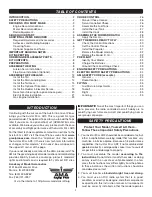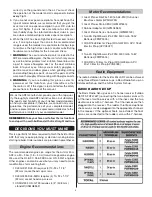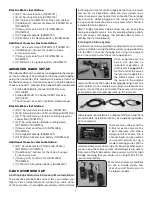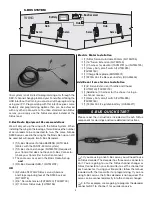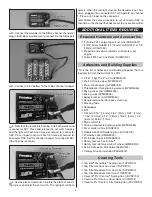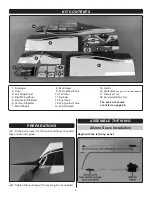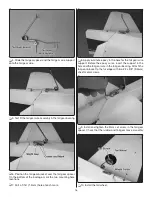
3
correctly on the ground and in the air. You must check
the operation of the model and all components before
every
fl ight.
5. If you are not an experienced pilot or have not fl own this
type of model before, we recommend that you get the
assistance of an experienced pilot in your R/C club for
your fi rst fl ights. If you’re not a member of a club, your
local hobby shop has information about clubs in your
area whose membership includes experienced pilots.
6. While this ARF has been fl ight-tested to exceed normal
use, if an engine larger than one in the recommended
range is used, the modeler is responsible for taking steps
to reinforce the high stress points and/or substituting
hardware more suitable for the increased stress.
7.
WARNING:
The cowl and wheel pants included in this
ARF are made of fi berglass, the fi bers of which may cause
eye, skin and respiratory tract irritation. Never blow into
a part to remove fi berglass dust, as the dust will blow
back into your eyes. Always wear safety goggles, a
particle mask and rubber gloves when grinding, drilling
and sanding fi berglass parts. Vacuum the parts and the
work area thoroughly after working with fi berglass parts.
8.
WARNING:
If you are building this plane as electric
powered, set the failsafe on your transmitter so that
the motor is off if the signal is lost and follow the safety
precautions in the back of the manual.
We, as the ARF manufacturer, provide you with a top qual-
ity, thoroughly tested ARF and instructions, but ultimately
the quality and fl yability of your fi nished model depends
on how you assemble it; therefore, we cannot in any way
guarantee the performance of your completed model,
and no representations are expressed or implied as to the
performance or safety of your completed model.
REMEMBER:
Take your time and follow the instructions
to end up with a well-built model that is straight and true.
DECISIONS YOU MUST MAKE
This is a partial list of items required to fi nish the Avistar 30cc
ARF that may require planning or decision making before
starting to build. Order numbers are provided in parentheses.
Engine Recommendations
The recommended engine size range for the Avistar 30cc
ARF is a 30 – 35cc [1.8 – 2.0 ci] two-stroke gasoline engine.
We used the DLE-30, DLE-35RA and O.S. 33GT engines.
Other engines can also be used but you may need to make
modifications for mounting them.
❍
DLEG0031 DLE-30 requires (4) 10-32 x 1-1/4"
(32 mm) socket head cap screws
❍
DLEG0435 DLE-35RA requires (4) 10-32 x 1-1/4"
(32 mm) socket head cap screws
❍
OSMG1533 O.S. GT33 requires (4) 2" ( 50.8 mm)
standoff (OSMG8962)
Motor Recommendations
❍
Great Planes RimFire 1.60 [63-62-250] Outrunner
Brushless Motor (GPMG4795)
❍
Great Planes SS-60 ESC (GPMM1850)
❍
Spinner Adapter Kit (GPMQ4589)
❍
Great Planes Series Connector (GPMM3143)
❍
Two 5S FlightPower LiPo FP50 5000 mAh 18.5V
Batteries (FPWP5505)
❍
XOAR 18x8 Electric Prop (XOAQ4079) Or APC 18 x 8
Electric Prop (APCQ4021)
OR
❍
Two 4S FlightPower LiPo FP50 5000 mAh 14.8V
Batteries (FPWP5504)
❍
XOAR 20 x10 Electric Prop (XOAQ4096) or APC
20 x10 Electric Prop (APCQ4028)
Radio Equipment
The radio installation for the Avistar 30cc ARF can be achieved
using three different radio set-ups: a Basic Radio Set-up, an
Advanced Set-up and the S.Bus System Set-up.
BASIC RADIO SET-UP
The Basic Radio Set-up uses a 7-channel receiver (Futaba
R617FS FUTL7627) connecting the two aileron servos with
a Y-harness, two fl ap servos with a Y-harness and the two
elevator servos with a Y-harness. The Y-harnesses are then
plugged into the receiver. The rudder, throttle and optional
choke servos are also plugged into the appropriate channels
in the receiver. If the optional fl oats are installed, the fl oat
servos are connected to the rudder servo with a Y-harness.


